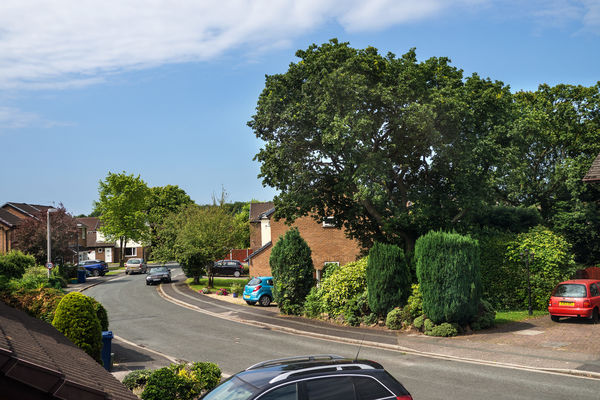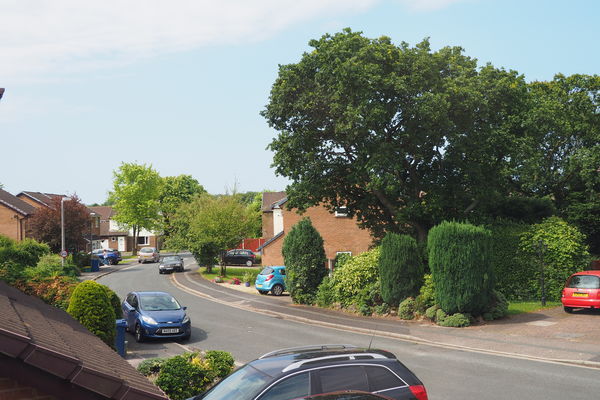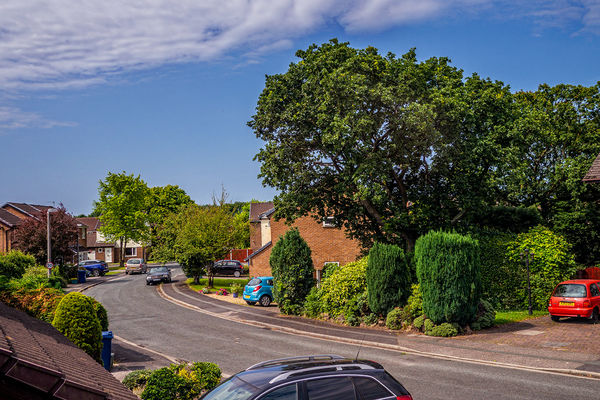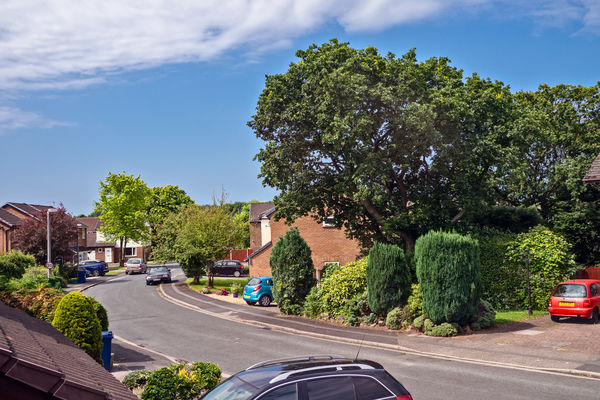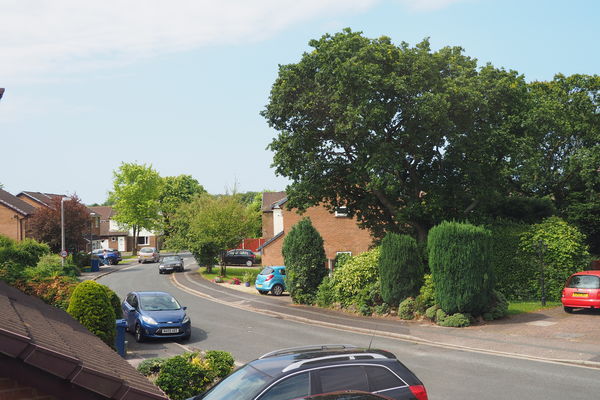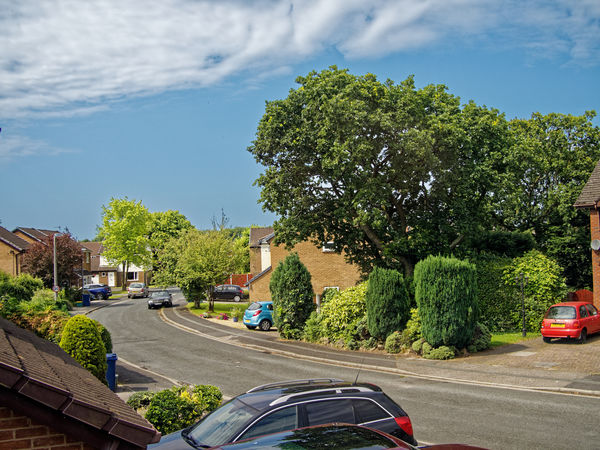RAW vs Jpeg (again)
Jul 17, 2019 08:29:10 #
PGHphoto
Loc: Pittsburgh, PA
johneccles wrote:
I haven't used RAW for several years but I am going to try photographing in RAW once again
Attached are two identical photographs taken through my office window, one in RAW and one in Jpeg.
In your opinion which one is better.
Attached are two identical photographs taken through my office window, one in RAW and one in Jpeg.
In your opinion which one is better.
Comparing Raw to JPG is like choosing between Ikea and a lumberyard when you want to put together a bookshelf. Both can give you the basic materials to create the bookshelf. Ikea (like JPG) will only give you what you need to make a bookshelf. You can paint it (the equivalent of PP) but you don't have extra pieces to make it substantially different from what you are given. The lumber yard (RAW files) gives you the choices of what wood to use, how to finish it, how detailed you want it (maybe add some doors) because all of the data recorded by the sensor is available for you to play with.
The difference is not really about what you see in the file that comes out of the camera but what is available to you behind the scenes in each file. Normally, if a shadow is too dark in a JPG file, you can only lighten it in PP because there is no more detail hiding behind the scenes. In RAW, chances are you have actual detail lurking in the shadows that can be brought out. In a RAW file, subtle shading or lines often may be pulled out of what a JPG - even with PP - will only show as a solid dark mass.
Jul 17, 2019 09:24:17 #
PGHphoto wrote:
That is one of the best analogies I've read to date Comparing Raw to JPG is like choosing between Ikea... (show quote)


#1 below is OP's raw file edited in PS Elements.
#2 is the jpg he posted.
#3 rmalarz's from page 1 of this thread. See, when you start with raw you can cook it to your own tastes!
Jul 17, 2019 09:30:44 #
RichieC
Loc: Adirondacks
People refuse to understand what a RAW file is. It becomes tedious.
A RAW file is ONLY a digital negative before the print. Holding up a negative to the light and comparing it to a print is comparing apples and oranges. Or a better analogy might be - holding up an orange seed and an orange—and lazy idiots will say the orange is better- I only eat oranges- they taste better than that old seed, therefore they are better. ..But you need one to make the other.
Shooting and working in RAW vs. JPEG ONLY represents a work flow… I happen to shoot both at the same time, My D800e crates a duplicate high res JPEG along with an NEF ( Nikon’s proprietary RAW/digital negative format). If the JPEG is good enough, or only needs to be tweaked a bit- great! if it is an Art print or i had to underexpose because i required a faster shutter speed etc., I process the NEF file- then i save is as a JPEG file. At the very end of this is a definition if what a JPEG actually is- (just a widely supported compression algorithm).
So if you want to compare the two, compare a self processed RAW file saved as a jpeg vs. the JPEG your camera produces from a RAW file. You see, all images, every single one, starts out as a RAW file from your sensor. Your camera mindlessly creates a JPEG from it using some settings either the factory used or you may have some control like “Vivid” or "Portrait” or "Landscape” . in the old days- this is all you got from your digital camera. Someone said- “HEY! I have brain and photoshop, and i’d like to work on the RAW image file before my weenie computer in my camera and the settings applied to it that some Japanese dude 4000 miles away decided to tell the cameras computer what to enhance, adjust and balance”
If you held up an Ansel Adams negative, you’d have nothing worth looking at. He shot to capture all detail- that is all. He wasn't done- he had work to do and needed all the data prossible in the negative. ( If you have one, I’d happily take it off yoru hands though :) In fact if you simply sent one of his negatives off for a regular enlargement- you’d still not get anything much close to what hangs in museums. HE highly and expertly ( brilliantly on the scale of Mozart) processed the negative for his final product/print.
The RAW file is the score.. the print is the performance. in RAW your cameras computer is the musicians and conductor, in RAW--- YOU are.
Definition of JPEG....
What does JPEG stand for?
JPEG stands for “Joint Photographic Experts Group”. It’s a standard image format for containing lossy and compressed image data. Despite the huge reduction in file size JPEG images maintain reasonable image quality. This unique compression feature allows JPEG files to be used widely on the Internet, Computers, and Mobile Devices. The sharing of JPEG images is quick and efficient. Also, a large number of JPEG image files can be stored in minimum storage space. JPEG files can also contain high-quality image data with a lossless compression. In PaintShop Pro JPEG is a commonly used format for storing the edited images.
https://www.google.com/search?client=firefox-b-1-d&q=what+does+JPEG+stand+for
A RAW file is ONLY a digital negative before the print. Holding up a negative to the light and comparing it to a print is comparing apples and oranges. Or a better analogy might be - holding up an orange seed and an orange—and lazy idiots will say the orange is better- I only eat oranges- they taste better than that old seed, therefore they are better. ..But you need one to make the other.
Shooting and working in RAW vs. JPEG ONLY represents a work flow… I happen to shoot both at the same time, My D800e crates a duplicate high res JPEG along with an NEF ( Nikon’s proprietary RAW/digital negative format). If the JPEG is good enough, or only needs to be tweaked a bit- great! if it is an Art print or i had to underexpose because i required a faster shutter speed etc., I process the NEF file- then i save is as a JPEG file. At the very end of this is a definition if what a JPEG actually is- (just a widely supported compression algorithm).
So if you want to compare the two, compare a self processed RAW file saved as a jpeg vs. the JPEG your camera produces from a RAW file. You see, all images, every single one, starts out as a RAW file from your sensor. Your camera mindlessly creates a JPEG from it using some settings either the factory used or you may have some control like “Vivid” or "Portrait” or "Landscape” . in the old days- this is all you got from your digital camera. Someone said- “HEY! I have brain and photoshop, and i’d like to work on the RAW image file before my weenie computer in my camera and the settings applied to it that some Japanese dude 4000 miles away decided to tell the cameras computer what to enhance, adjust and balance”
If you held up an Ansel Adams negative, you’d have nothing worth looking at. He shot to capture all detail- that is all. He wasn't done- he had work to do and needed all the data prossible in the negative. ( If you have one, I’d happily take it off yoru hands though :) In fact if you simply sent one of his negatives off for a regular enlargement- you’d still not get anything much close to what hangs in museums. HE highly and expertly ( brilliantly on the scale of Mozart) processed the negative for his final product/print.
The RAW file is the score.. the print is the performance. in RAW your cameras computer is the musicians and conductor, in RAW--- YOU are.
Definition of JPEG....
What does JPEG stand for?
JPEG stands for “Joint Photographic Experts Group”. It’s a standard image format for containing lossy and compressed image data. Despite the huge reduction in file size JPEG images maintain reasonable image quality. This unique compression feature allows JPEG files to be used widely on the Internet, Computers, and Mobile Devices. The sharing of JPEG images is quick and efficient. Also, a large number of JPEG image files can be stored in minimum storage space. JPEG files can also contain high-quality image data with a lossless compression. In PaintShop Pro JPEG is a commonly used format for storing the edited images.
https://www.google.com/search?client=firefox-b-1-d&q=what+does+JPEG+stand+for
Jul 17, 2019 09:31:41 #
Jul 17, 2019 10:10:25 #
Richie, it's not even that. It's equivalent to the latent image on a film negative. Nothing can be seen until it's processed.
The difference, RAW and jpg, is equivalent to a film photograph vs. a polaroid photography. Not a lot can be done with the Polaroid, as it arrives cooked per the manufacturer's specifications. Film can be a bit more flexible. The amount depends on color negative/transparency or black and white negative.
--Bob
The difference, RAW and jpg, is equivalent to a film photograph vs. a polaroid photography. Not a lot can be done with the Polaroid, as it arrives cooked per the manufacturer's specifications. Film can be a bit more flexible. The amount depends on color negative/transparency or black and white negative.
--Bob
RichieC wrote:
People refuse to understand what a RAW file is. It... (show quote)
Jul 17, 2019 10:20:48 #
johneccles wrote:
I haven't used RAW for several years but I am going to try photographing in RAW once again
Attached are two identical photographs taken through my office window, one in RAW and one in Jpeg.
In your opinion which one is better.
Attached are two identical photographs taken through my office window, one in RAW and one in Jpeg.
In your opinion which one is better.
I come late to this gathering of Foto Fans but I had to give the RAW file a try. My result is markedly similar to others, which I believe shows there isn't any secret magic that one of us possess. It also shows to some extent that JPEGs SOOC are not optimal and most anyone can improve on the camera's output when processing the RAW file
Jul 17, 2019 10:32:15 #
If you're going to post an unprocessed RAW image and ask us to compare it to anything, you've demonstrated you:
1) don't know what you're doing
2) don't know why you're doing it
3) don't know what you should be doing regarding RAW
For the people who choose to edit your image for you, you're just wasting their time. What are they going to do, buy you their software and edit all your images going forward?
1) don't know what you're doing
2) don't know why you're doing it
3) don't know what you should be doing regarding RAW
For the people who choose to edit your image for you, you're just wasting their time. What are they going to do, buy you their software and edit all your images going forward?
Jul 17, 2019 10:44:47 #
CHG_CANON wrote:
If you're going to post an unprocessed RAW image and ask us to compare it to anything, you've demonstrated you:
1) don't know what you're doing
2) don't know why you're doing it
3) don't know what you should be doing regarding RAW
For the people who choose to edit your image for you, you're just wasting their time. What are they going to do, buy you their software and edit all your images going forward?
1) don't know what you're doing
2) don't know why you're doing it
3) don't know what you should be doing regarding RAW
For the people who choose to edit your image for you, you're just wasting their time. What are they going to do, buy you their software and edit all your images going forward?
I certainly don't feel my time has been wasted as my intent was to demonstrate the value of working with RAW files in hope that the OP (and those doubting Thomas's out there) will be encouraged to move beyond their camera's formulaic JPEG output.
It could be that your points 1- -3 are accurate but we learn through inquiry.
Jul 17, 2019 10:47:13 #
Rich1939 wrote:
I certainly don't feel my time has been wasted as my intent was to demonstrate the value of working with RAW files in hope that the OP (and those doubting Thomas's out there) will be encouraged to move beyond their camera's formulaic JPEG output.
It could be that your points 1- -3 are accurate but we learn through inquiry.
It could be that your points 1- -3 are accurate but we learn through inquiry.
Where in the OP's post did they ask you to edit their work?
If fact, a properly worded complaint sent to ADMIN could have you kicked-off the site, as has been applied to other members doing the same action.
Jul 17, 2019 10:47:32 #
RichieC wrote:
People refuse to understand what a RAW file is. It becomes tedious.
A RAW file is ONLY a digital negative before the print.
...
...
A RAW file is ONLY a digital negative before the print.
...
...
I would probably consider the RAW file the latent image and the RAW editor the "chemicals to develop" the negative and the enlarger to make a print.
Jul 17, 2019 10:50:08 #
Jul 17, 2019 10:54:34 #



--Bob
Longshadow wrote:
I would probably consider the RAW file the latent image and the RAW editor the "chemicals to develop" the negative and the enlarger to make a print.
Jul 17, 2019 10:55:29 #
Good point. Perhaps Paul is just having one of those mornings. Most of us get them from time to time.
--Bob
[quote=Rich1939]
--Bob
[quote=Rich1939]
CHG_CANON wrote:
Where in the OP's post did he ask for attitude?
Jul 17, 2019 10:58:46 #
rmalarz wrote:
Good point. Perhaps Paul is just having one of those mornings. Most of us get them from time to time.
--Bob
--Bob



 Not me
Not me 
Jul 17, 2019 10:59:41 #
mwsilvers
Loc: Central New Jersey
johneccles wrote:
I haven't used RAW for several years but I am going to try photographing in RAW once again
Attached are two identical photographs taken through my office window, one in RAW and one in Jpeg.
In your opinion which one is better.
Attached are two identical photographs taken through my office window, one in RAW and one in Jpeg.
In your opinion which one is better.
You need to understand that the ONLY reason to shoot raw is if you are planning to post process your images. Raw gives you much more range and latitude than jpegs when editing. Straight out of the camera raw files generally don't look at good as jpegs because they don't have the in-camera settings for sharpness, contrast, color tone etc. that are automatically applied to jpegs. Comparing a straight out of the camera raw file with a jpeg is therefore a useless exercise. If you have no intention of editing you images on a regular basis, continue shooting jpeg.
However, since you did provide the raw file, I downloaded it and took the liberty of editing it just a bit so you can see the difference. I exported it to a jpeg and am posting your jpeg followed by mine. As an interesting side note, the jpeg you posted is not based on the raw file you attached. They have different file names, a slightly different angle, and there is a missing car in the raw file.
If you want to reply, then register here. Registration is free and your account is created instantly, so you can post right away.

